List of sesame seed dishes
This is a list of notable sesame seed dishes and foods, which are prepared using sesame seed as a main ingredient. Sesame seed is a common ingredient in various cuisines, and is used whole in cooking for its rich, nutty flavor.

A magnified view of sesame seeds
Sesame-seed dishes and foods
Tahini with lemon and garlic
- Benne Wafer - a wafer-like cookie made primarily from sesame seed and sesame flour. Very popular in Charleston, South Carolina. The sesame seed, also called "benne," is thought have been brought to colonial American by West African slaves.
- Binangkal – a doughnut from the islands of Visayas and Mindanao in the Philippines, it is made from deep fried dense dough balls coated with sesame seeds.[1][2][3] It is usually eaten with hot chocolate or coffee.[4]
- Black sesame roll – a refrigerated dim sum dessert found in Hong Kong and some overseas Chinatowns. It is sweet and the texture is smooth and soft.
- Black sesame soup – a popular east-Asian and Chinese dessert widely available throughout China, Hong Kong and Singapore,[5]
- Chikki – a traditional Indian sweet sometimes prepared using sesame seeds
- Furikake – a dry Japanese seasoning[6] meant to be sprinkled on top of cooked rice, vegetables, and fish. It typically consists of a mixture of dried and ground fish, sesame seeds, chopped seaweed, sugar, salt, and monosodium glutamate.[7][8]
- Gajak – a dessert originating at Bhind and Morena of Madhya Pradesh, India where it is most commonly consumed in the winter months. It is a dry sweet made of sesame seeds, ground nuts and jaggery.
- Goma-ae – a Japanese side dish made with vegetables and sesame dressing (goma meaning sesame and ae meaning sauce in Japanese)
- Gomashio – a dry condiment made from unhulled sesame seeds
- Heugimja-juk – black sesame porridge, a juk (porridge) made from finely ground black sesame and rice.[9][10] The bittersweet, nutty porridge is good for recovering patients, as black sesame seeds are rich in digestive enzymes that help with healthy liver and kidney functions.[10]
- Injeolmi – a variety of tteok, or Korean rice cake sometimes prepared using sesame seeds
- Jian dui – a fried Chinese pastry made from glutinous rice flour, it is coated with sesame seeds on the outside and is crisp and chewy
- Ka'ak – can refer to a bread commonly consumed throughout the Near East that is made in a large ring-shape and is covered with sesame seeds
- Tahini – a condiment made from toasted ground hulled sesame seeds. Tahini is served as a dip on its own or as a major component of hummus, baba ghanoush, and halva.
- Tilkut – a sweet made in the Indian states of Bihar and Jharkhand, it is made of pounded 'tila' or sesame seeds (Sesamum indicum) and jaggery or sugar
- Sesame halva – sweet confections popular in the Balkans, Poland, the Middle East, and other areas surrounding the Mediterranean Sea
- Sesame-seed cake – a cake made of sesame seeds, often combined with honey as a sweetener
- Changzhou Sesame Cake – a type of elliptical, baked cake that originated in Changzhou, Jiangsu, China supposedly over 150 years ago
- Huangqiao Sesame Cake – a sesame-seed cake[11] that originated from Huangqiao town in Taixing, Jiangsu.[12] It has been speculated to be one of the oldest cakes in the Taizhou region of China.[13]
- Sesame-seed candy – a confection of sesame seeds and sugar or honey pressed into a bar or ball, it is popular from the Middle East through South Asia to East Asia.
- Changzhou sesame candy – a traditional cookie in places such as Changzhou, China
- Tilgul – a colourful sesame-seed candy coated with sesame seeds, in Maharashtra, India people exchange tilgul on Sankranti, a Hindu festival celebrated on 14 January.
- Sesame-seed dishes and foods
- Sesame seeds being harvested in Mozambique
.jpg)
- Halo! brand sesame seed biscuits
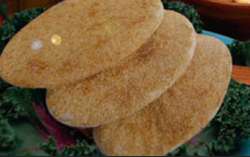

- Sesame-seed chikki
 Ellunda
Ellunda
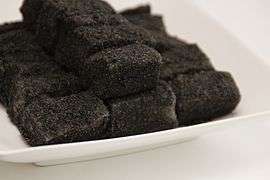 black sesame injeolmi
black sesame injeolmi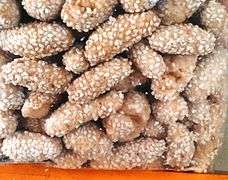 Keciput
Keciput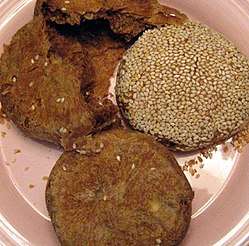
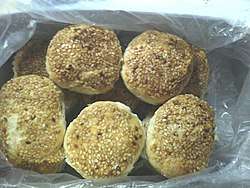
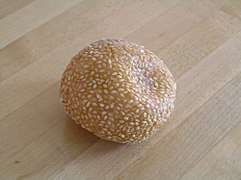
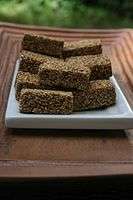 Puerto Rican sesame-seed candy
Puerto Rican sesame-seed candy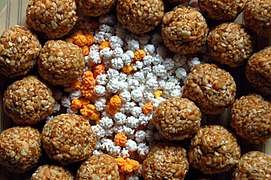
.jpg) Black sesame ice cream
Black sesame ice cream
References
- Dawn Bohulano Mabalon (2013). "As American as Jackrabbit Adobo: Cooking, Eating, and Becoming Filipina/o American before World War II". In Robert Ji-Song Ku; Martin F. Manalansan; Anita Mannur (eds.). Eating Asian America: A Food Studies Reader. NYU Press. p. 169. ISBN 9781479869251.
- Belle Piccio (6 August 2013). "Binangkal: A Cebuano Native Delicacy". Choose Philippines. Retrieved 2 December 2016.
- "Binangkal Recipe". Kusinera Davao. Retrieved 2 December 2016.
- Bernadette Parco (15 September 2016). "'Hikay': Cookbook hopes to keep Cebuano cookery alive". GMA News Online. Retrieved 2 December 2016.
- MzTasty's Kitchen, "Black Sesame Soup", Petitchef, retrieved 12 August 2012
- Japanese Furikake (Rice Seasoning) Archived 2011-08-25 at the Wayback Machine. Japanese Kitchen. Accessed 28 October 2009.
- Mouritsen, Ole G. (2009). Sushi food for the eye, the body & the soul (2nd ed.). New York: Springer. p. 113. ISBN 978-1441906182.
- Ambrose, Amber (12 April 2010). "Random Ingredient of the Week: Furikake". Houston Press. Retrieved 22 November 2015.
- (in Korean) "주요 한식명(200개) 로마자 표기 및 번역(영, 중, 일) 표준안" [Standardized Romanizations and Translations (English, Chinese, and Japanese) of (200) Major Korean Dishes] (PDF). National Institute of Korean Language. 2014-07-30. Retrieved 2017-02-14. Lay summary.
- "heugimja juk" 흑임자죽 [Black Sesame and Rice Porridge]. Korean Food Foundation. Retrieved 28 March 2017.
- "Yat-sen Cake Archived 2011-04-03 at the Wayback Machine. en.jiangyin.gov.cn Archived 2014-04-01 at the Wayback Machine. Accessed September 2011.
- Chen, Zishan (2005). Food and Chinese culture: essays on popular cuisine. Long River Press. pp. 171–172. ISBN 978-1-59265-049-1.
- "Huangqiao Sesame Seed Cake (黄桥烧饼)." English.taizhou.gov.cn. Accessed September 2011.
External links

This article is issued from Wikipedia. The text is licensed under Creative Commons - Attribution - Sharealike. Additional terms may apply for the media files.
